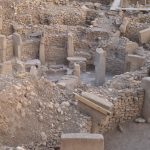Old Menteşe capital Population: abandoned
Other names: Pezona
If you’ve been living in Turkey for some time you will need no introduction to the Ottomans. You may even know a fair amount about the Selçuks. But the Menteşes will probably be new to you.
The Selçuk Sultanate of Rum was one of the great powerhouses of the Middle Ages, but its authority came to an end in 1243 when the sultan was defeated by the Mongols at the Battle of Kösedağ.
In the power vacuum that followed, several emirates were established in Western Anatolia. One of these was founded by Menteşe Bey who, at the height of his power, governed all the land between modern Aydın and Fethiye. During the reign of his grandson Orhan Bey, Beçin, just outside modern Milas, became the capital of the Menteşe emirate.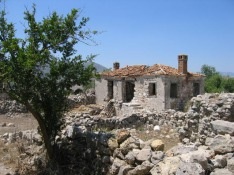
Over the ensuing decades the emirate reached out its tentacles until eventually it controlled land as far away as Finike. But that turned out to be a stretch too far, and in 1358 the emirate split into two separate parts. Ahmed Ghazi became ruler of the southern half of the emirate and he it was who expanded Beçin to its greatest extent.
But with the increasingly powerful Ottomans breathing down their necks, the Menteşes were destined to become a footnote in history. In 1390 Beçin fell to the Ottomans for the first time, only to be recaptured briefly by the Menteşes in 1402. But by 1426 their time was up and Beçin was swallowed up into the Ottoman Empire.
Until recently the evocative site of the old Menteşe capital slumbered in virtual anonymity despite its proximity to some of the busiest holiday resorts of south-west Turkey. Now, however, it is a potential world heritage site and a ticket office has been installed along with shops, cafes, a car park and more durable paths.
The Karia Yolu (Carian Way) passes by Beçin Castle.
Around the site
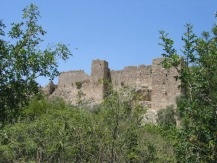 As you approach from Milas, you see what looks like one of the great Crusader castles of the Middle East clinging to a rock high above you. From below it looks virtually impregnable but a road sweeps round to the rear and deposits visitors right by the steps leading into the interior.
As you approach from Milas, you see what looks like one of the great Crusader castles of the Middle East clinging to a rock high above you. From below it looks virtually impregnable but a road sweeps round to the rear and deposits visitors right by the steps leading into the interior.
In an area which was intensively settled in Carian times it’s hardly surprising to find that the Menteşes built their castle over an old temple to Zeus Carius; the marble steps of its platformed base rise up beside the path with medieval masonry right on top of them.
From the walls of the castle the Menteşes would have had a spectacular view of the surrounding plain and any approaching enemies. But whatever its original military function, the castle later became just another walled village (Mutluca), inhabited until as recently as the 1970s. Today its interior is full of the remains of small stone houses that must have looked just like those in the older parts of Milas. The only other structure whose purpose can be readily distinguished is a tiny, broken-down hamam right in the centre.
But the remains of the castle are far from all that Beçin has to offer. In fact medieval ruins sprawl for some distance into the surrounding olive groves and you can spend several very happy hours exploring them with only the twittering of goldfinches to disturb you.
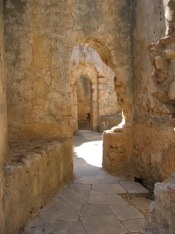 Straight ahead from the castle entrance is the impressive Great Hamam which must once have been a huge and imposing bathhouse, its floors tiled in marble probably taken from the older Carian settlement of Mylasa, its walls plastered and enclosed with domes. The hamam continued in use long after the Menteşes had vanished. Written sources report that bandits holed up there in 1610 and used it as a base to carry out robberies, and in the 17th century its entrances appear to have been narrowed. After that, however, we hear no more about it.
Straight ahead from the castle entrance is the impressive Great Hamam which must once have been a huge and imposing bathhouse, its floors tiled in marble probably taken from the older Carian settlement of Mylasa, its walls plastered and enclosed with domes. The hamam continued in use long after the Menteşes had vanished. Written sources report that bandits holed up there in 1610 and used it as a base to carry out robberies, and in the 17th century its entrances appear to have been narrowed. After that, however, we hear no more about it.
A short walk away from the hamam is a much less well-preserved structure which appears to have been one of the 14th-century zawiyahs (guesthouses) mentioned by the famous medieval Moroccan travel writer, Ibn Battuta.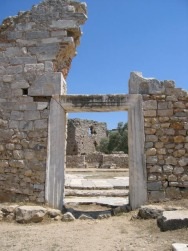
From the zawiyah the path continues straight ahead to what still feels like the busy centre of old Beçin. It is dominated by the remains of the Ahmed Ghazi Medrese, a fairly simple building erected in 1375 and fronted by a rather Gothic-looking arch. Inside four iwans (arched recesses) enclose its courtyard, the northern one containing the tombs of Ahmed Ghazi, most famous of the Menteşe emirs, and his wife; they are still a popular site of pilgrimage for Turkish visitors. Sadly on my last visit the gates were locked.
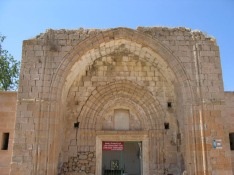 Set in the outside wall above the arched opening to the iwan, a pair of stone lions wave inscribed banners, a rare decorative touch in a fairly austere building.
Set in the outside wall above the arched opening to the iwan, a pair of stone lions wave inscribed banners, a rare decorative touch in a fairly austere building.
Immediately opposite the medrese stand the far scantier remains of the Orhan Cami, which was still under construction when Ibn Battuta passed through. Completed in about 1335 reusing materials from Mylasa, the original mosque appears to have burnt down and then been rebuilt on a smaller scale; today only the lower walls, the marble doorway, and uneven marble paving stones remain.
Many other buildings cluster around the heart of the settlement. In particular it’s worth popping behind the Ahmed Ghazi Medrese to inspect the ruins of the 15th-century Bey’s Hamam; on the walls you can still just about make out traces of decorations stamped into the plaster with a mould. Today it has become a sideshow in a litter-strewn picnic area.
Also worth a quick look is the crudely restored Kübbeli Çeşme (Domed Fountain) which seems to have been the city’s main source of water. It was supplied by a spring which was probably already in use in Carian times.
A well-marked path through the site meanders past the remains of the two-storied 15th-century Kızıl Hanı (Red Han), a caravanserai-like structure where trade goods would have been stored, and traders and their animals accommodated. It then cuts through the old city wall and the scattered remains of what was once a larger zawiyah (guesthouse), with its own hamam and mescit.
If you keep walking through the scrub you eventually arrive at the romantically isolated Menteşe cemetery, where a few curvy inscribed marble tombstones dating back to the 14th and 15th centuries gaze out over lovely, tree-covered hills.
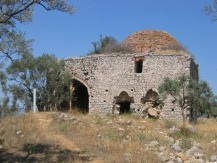 The path keeps going until it reaches the remains of the Yelli Külliyesi, a complex which included a stone-built mosque with portico and dome; the latter has caved in but you can still see how its weight was supported on corner corbels.
The path keeps going until it reaches the remains of the Yelli Külliyesi, a complex which included a stone-built mosque with portico and dome; the latter has caved in but you can still see how its weight was supported on corner corbels.
If it’s not too hot and you’re not too tired of history, you can keep going due south to find the ruins of the early 15th-century Karapaşa Medrese. The remains of a forest tekke (dervish lodge) to the west were so completely buried in the scrub that they were only rediscovered in 2000.
There is nowhere to buy a drink at the site and very little shade, so make sure you come well prepared.
Beçin itself has no accommodation although Milas has several possibilities.
Transport info
Beçin is only five km from the centre of Milas which means that you could easily walk there. However, the climb up to the castle is a stiff one. Milas taxi drivers will be happy to drive you there and back. Make sure to agree a price including waiting time before setting off. I usually take a taxi up, then walk back down and hope to pick up the dolmuş from Beçin village to Milas along the way.
Read more about my visit to Beçin: http://turkeyfromtheinside.com/blogbloggingaboutturkey/entry/81-the-goatherd-of-be%C3%A7in.html

